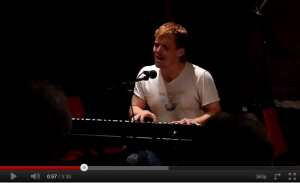We had a good turnout for the first session of our Sacred Harp singing school at the Palo Alto church: we had set out 54 chairs, and at one point every chair was taken. A dozen or so experienced Sacred Harp singers showed up to help support Marsha Genensky, our singing master for the day. The new singers were about evenly split between people who had sung a few times at a local Sacred Harp singing, and people who had never sung Sacred Harp before but who had some singing experience.
Marsha traced the background of solfege syllables from the Middle Ages up to the development of the “fa, sol, la, mi” syllables used in early American singing schools. She demonstrated how the scale worked with only four solfege syllables: fa, sol, la, fa, sol, la, mi, and back to fa. She showed the class how early American hymnals printed the syllables “F, S, L, M” to indicate pitch. Later, these same syllables were printed beneath standard round-headed notes, and finally notes with different shaped note heads were developed to help make it easy to sight-read a piece of music: fa corresponded to a triangular note head, sol to a round note head, la to a rectangular note head, and mi to a diamond-shaped note head. (Link to a sample scale in shape notes.)
Marsha then organized the class into a scale: some people sang a low fa, a different small group so, the next group la, and so on up the scale. Then she told us to sing our note when she pointed at us — and by “playing us like a marimba,” she had us sing the tune to “Amazing Grace.” (She also told the class that the name of the tune is actually “New Britain,” while the name of the hymn or poem is “Amazing Grace.”)
By this time, the class was ready to sing some songs, and Marsha led us through a couple of easy songs. She had each section — altos, trebles (with men and women singing an octave apart), tenors (the melody line, with men and women singing an octave apart), and basses — sing their part separately and slowly, using the “fa, sol, la, mi” syllables. Then she put us together so that we were singing in four parts. The experienced singers kept us on our parts, and there were plenty of other fine voices in the room, so we sounded great!
After an hour of the singing school, we segued into the regular bimonthly Palo Alto singing. The tempo of the songs picked up, and at times some of the new singers got a little lost, but from where I sat in the back of the bass section, everyone I could see was enjoying themselves, and enjoying the music.
Historical note: The singing school was a regular feature of eighteenth century American life, and persisted well into the nineteenth century in America outside of urban areas. The singing school continued through the twentieth century in the rural South in the tradition of Sacred Harp singing (so named because the tune book used by the tradition is titled “The Sacred Harp”), and today is enjoying a revival outside the South in northern and Western cities, and abroad in Ireland, England, Australia, and even Poland. The singing school remains an excellent way to teach people how to sing, which is why I brought a singing school to our Unitarian Universalist church in Palo Alto.

